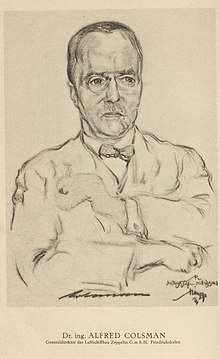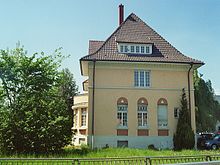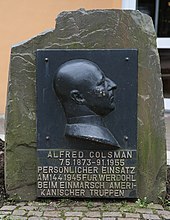Alfred Colsman

Alfred Colsman (born May 7, 1873 in Werdohl ; † January 9, 1955 ) was a German engineer and manager who, as director general and architect of the Zeppelin Group , played a key role in the development of airship travel in the name of Ferdinand Graf von Zeppelin .
Life
His father Johann Friedrich Colsman owned a factory in Werdohl which manufactured various products from the then new material aluminum . Like his brothers Carl and Rudolf Colsman, he prepared himself for a later position in this company by studying at the Technical University (Berlin-) Charlottenburg , where he became a member of the Corps Rheno-Guestphalia , and by traveling abroad.
In 1899 he married Helene Berg, a daughter of the Lüdenscheid factory owner Carl Berg , whose company also processed aluminum and built his airship out of sheet aluminum for the airship pioneer David Schwarz as early as 1892 . In 1897, Graf Zeppelin tried to win Berg for his idea of airship construction and now manufactured the aluminum frame for his zeppelins , initially that of the LZ 1 . After the death of his father-in-law, Colsman sat on the Berg company supervisory board from 1907 . He personally met the count for the first time in his birthplace, the Inselhotel in Konstanz, and then visited the floating hall construction with him in Friedrichshafen , with that of the Z1, which is currently under construction. A second meeting took place in 1906 at the funeral of Carl Berg. There, Count von Zeppelin Colsman expressed his wish to found a new airship building company. The first founding members were the metal goods factory Carl Berg and Friedrich Krupp GmbH.
When, after the miracle of Echterdingen on August 5, 1908, the people's donation brought in more than 6.3 million marks (according to today's monetary value approx. EUR 100 million) in donations to Count Zeppelin , Colsman was appointed general director ( chairman of the board ) - but without a certificate of appointment , because the previous organization of the LZ was not viable. This donation flowed into a foundation for the promotion of "airship construction and airship travel" and thus served a new beginning. Zeppelin-Luftschiffbau GmbH was founded on September 8, 1908, and finally the Zeppelin Foundation on December 30, 1908.
The previous shipyard in Manzell was too small for his plans and the maintenance of the swimming pool on the lake was too cost-intensive. With the purchase of a property of 75 hectares in FN-Waggershausen the foundation stone was laid for an expansion.
In 1910, Colsman was on board the Zeppelin LZ 7 , which crashed nine days after the maiden voyage on June 28 after an engine failure in the storm on Limberg near Bad Iburg in the Teutoburg Forest . Nobody was harmed in the accident.
Alfred Colsman founded several subsidiaries for different, function-specific tasks:
- 1909, the first air shipping company in the world, the Deutsche Luftschiffahrs-AG ( DELAG ), whose board function he was next to Hugo Eckener .
- 1909, Kurgarten-Hotel GmbH (today's grounds of the Graf-Zeppelin-Haus, as the hotel and residence of the Count von Zeppelin)
- 1909, Luftfahrzeug-Motorenbau GmbH. Karl Maybach became its head. In 1912 the company moved from Bissingen an der Teck to Friedrichshafen and renamed Motorenbau GmbH, then after WK 1 to Maybach-Motorenbau GmbH.
- 1909, Carbonium GmbH, for the production of hydrogen . In 1910 the plant exploded and led to the establishment of Zeppelin Hydrogen and Oxygen AG (ZEWAS)
- 1909, a balloon envelope factory in Berlin-Staaken , for the gas cells of the zeppelins.
- 1910, ZEWAS
- 1913, Zeppelin-Hallenbau GmbH, for the construction of the airship hangars.
- 1915, Zahnradfabrik Friedrichshafen GmbH , gearbox, to transfer the engine power to the propellers. Founded together with Max Maag , the supplier of the technical know-how, who had a 48% share.
- 1917, the Zeppelin-Werk Lindau GmbH, managed by Claude Dornier. The shipyard in Seemoos, the Do department, was integrated into the new company.
- 1918, Holzindustrie Meckenbeuren GmbH, to supply the group companies with construction and sawn timber.
In addition to the task of economic expansion, Colsman saw himself not only as a socially minded, but also as a committed entrepreneur. In 1913 - on the 75th birthday of the Count von Zeppelin - this commitment led to the decision to found Zeppelin-Wohlfahrt GmbH. At the same time, it was the beginning of the foundation of a wide-ranging social work. Colsman commissioned Paul Bonatz , who had made a name for himself with the construction of the Stuttgart main train station, to build a Zeppelin village, including its necessary infrastructure such as a dairy, savings bank, mill, etc. and even a bathing establishment. Single homes and dormitories were rented for unmarried employees. There was also a social station, maternity home, children's home and counseling for mothers. Six farms were bought or leased. There were workshops for repairs. Teuringer Talbahn GmbH was built and operated to transport agricultural products to Friedrichshafen and was a subsidiary of Zeppelin-Wohlfahrt GmbH.
Around 1930 Colsman withdrew from the Zeppelin Group because of fundamental differences of opinion with Hugo Eckener . He then lived again in Werdohl, where he also did research on local history. In Friedrichshafen, a larger street and one of the halls in the Graf-Zeppelin-Haus culture and congress center are named after Colsman. There is also the Colsman mansion, where Colsman lived with the family until 1931. In the history of the city of Friedrichshafen, Colsman and his achievements for his spin-offs and his entrepreneurial foresight in the Zeppelin Group are recognized even before Eckener's merits.
In the spring of 1945 he participated in the surrender of his hometown to the US Army without a fight and was briefly appointed mayor of Werdohl. After the war he became involved in the FDP , for which he ran unsuccessfully in the 1949 federal election.
Honors
- 1917: Honorary title of Kommerzienrath, conferred by the King of Württemberg, Wilhelm II
- 1925: Freedom of the city of Friedrichshafen
- 1929: Dr. hc ( honoris causa ), awarded by the techn. University of Stuttgart
- 1953: Great Cross of Merit of the Federal Republic of Germany
- 1953: A street in Friedrichshafen is named after him
- 1993: Designation of a square in his native Werdohl, with construction
- 1995: a relief bust
- 2015: Opening of the Alfred Colsman House in Friedrichshafen
Fonts
- Airship ahead! 1933.
Individual evidence
- ^ Address list of the Weinheimer SC. 1928, p. 20.
- ↑ Helmut Braun: The rise and fall of airship travel - an economic historical analysis. eurotrans-Verlag, Regensburg 2007, ISBN 3-936400-22-9 , p. 150.
literature
- Tanja Bessler-Worbs: Alfred Colsman (1873–1955). Airship building veteran. In: Karl-Peter Ellerbrock, Tanja Bessler-Worbs: Industrial pioneers , economic citizens and managers. Historical entrepreneurs from the Märkisches Südwestfalen . (Small writings, booklet 32) Society for Westphalian Economic History e. V., Dortmund 2007, ISBN 978-3-87023-288-7 , pp. 154-158
- Rudolf Kaefer: Alfred Colsman. An unusual entrepreneur. 1873-1955. Friedrichshafen 2001, ISBN 978-3-88812-188-3 .
- Horst-Oskar Swientek: Colsman, Alfred. In: New German Biography (NDB). Volume 3, Duncker & Humblot, Berlin 1957, ISBN 3-428-00184-2 , p. 330 f. ( Digitized version ).
- Alfred Colsman , Internationales Biographisches Archiv 07/1955 of February 7, 1955, in the Munzinger Archive ( beginning of article freely accessible)
Web links
- Literature by and about Alfred Colsman in the catalog of the German National Library
- Newspaper article about Alfred Colsman in the 20th century press kit of the ZBW - Leibniz Information Center for Economics .
| personal data | |
|---|---|
| SURNAME | Colsman, Alfred |
| BRIEF DESCRIPTION | German engineer and manager |
| DATE OF BIRTH | May 7, 1873 |
| PLACE OF BIRTH | Werdohl |
| DATE OF DEATH | January 9, 1955 |
| Place of death | Werdohl |


